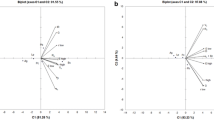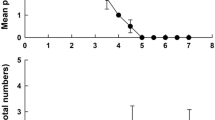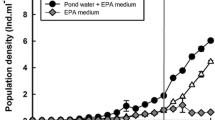Abstract
Members of rotifer family Asplanchnidae are important invertebrate predators in freshwater communities. Although a considerable amount of information exists on species of Asplanchna, relatively less is known about Asplanchnopus. We isolated Asplanchnopus multiceps from the littoral of a small river in the State of Hidalgo in Central Mexico and separated a clone in our cultures. The gut content analysis of some animals collected from the field revealed the presence of cladocerans and rotifers, and therefore we cultured A. multiceps on a food mixture comprising littoral rotifers and cladocerans. We conducted population growth experiments of A. multiceps using six prey types (cladocerans: Macrothrix triserialis, Alona rectangula and Pleuroxus aduncus; rotifers, Brachionus patulus, B. macracanthus and B. urceolaris). The prey species (A. rectangula and B. patulus) on which the highest growth rates were observed were used to test the life-table demographic patterns in A. multiceps. All experiments were conducted in 50 ml containers with 25 ml of the medium and at three food levels (0.5, 1.0 and 2.0 ind. ml−1 for the cladocerans, and 2.0, 4.0 and 8.0 ind. ml−1 for the rotifers) with four replicates at each treatment. The spines of M. triserialis and B. macracanthus were apparently effective deterrents against Asplanchnopus predation since both these diets resulted in low, and sometimes negative, growth rates of the predator. The average lifespan and net reproductive rate of A. multiceps ranged from 3.8 to 8.4 days and 2.6 to 12.2 ind. female−1, respectively, on A. rectangula; and from 5.0 to 9.4 days and 1.6–18.4 ind. female−1, respectively, on B. patulus. The rate of population increase of A. multiceps ranged from 0.1 to 0.8 d−1, depending on the prey type and density. The role of A. multiceps in structuring littoral rotifer and cladoceran communities is discussed.
Similar content being viewed by others
References
Anonymous, 1985. Methods of measuring the acute toxicity of effluents to freshwater and marine organisms. US Environment Protection Agency EPA/600/4-85/013
S. I. Dodson D. G. Frey (2001) Cladocera and other Branchiopoda J. H. Thorp A. P. Covich (Eds) Ecology and Classification of North American Freshwater Invertebrates Academic Press London 850–914
H. J. Dumont S. S. S. Sarma (1995) ArticleTitleDemography and population growth of Asplanchna sieboldi (Rotifera) as a function of prey (Anuraeopsis fissa) density Hydrobiologia 306 97–107 Occurrence Handle10.1007/BF00016827
H. J. Dumont S. S. S. Sarma A. J. Ali (1995) ArticleTitleLaboratory studies on the population dynamics of Anuraeopsis fissa (Rotifera) in relation to food density Freshwater Biology 33 39–46
J. J. Gilbert (1976) ArticleTitlePolymorphism in the rotifer Asplanchna sieboldi: Biomass, growth and reproductive rate of the saccate and campanulate morphotypes Ecology 57 542–551
J. J. Gilbert (1980) ArticleTitleObservations on the susceptibility of some protists and rotifers to predation by Asplanchna girodi Hydrobiologia 73 87–91 Occurrence Handle10.1007/BF00019431
J. J. Gilbert (1994) ArticleTitleSusceptibility of planktonic rotifers to a toxic strain of Anabaena flos-aquae Limnology and Oceanography 39 1286–1297
J. J. Gilbert (1996) ArticleTitleEffect of temperature on the response of planktonic rotifers to a toxic cyanobacterium Ecology 77 1174–1180
J. J. Gilbert (1999) Kairomone-induced morphological defenses in rotifers R. Tollrian C. D. Harvell (Eds) The Ecology and Evolution of Inducible Defenses Princeton Univ. Press NJ 127–141
S. E. Hampton P. L. Starkweather (1998) ArticleTitleDifferences in predation among morphotypes of the rotifer Asplanchna silvestrii Freshwater Biology 40 595–605 Occurrence Handle10.1046/j.1365-2427.1998.00359.x
N. Iyer T. R. Rao (1996) ArticleTitleResponses of the predatory rotifer Asplanchna intermedia to prey species differing in vulnerability: Laboratory and field studies Freshwater Biology 36 521–533 Occurrence Handle10.1046/j.1365-2427.1996.d01-510.x
H. Kappes C. Mechenich U. Sinsch (2000) ArticleTitleLong-term dynamics of Asplanchna priodonta in Lake Windsborn with comments on the diet Hydrobiologia 432 91–100 Occurrence Handle10.1023/A:1004022020346
Koste, W., 1978. Rotatoria. Die Rädertiere Mitteleuropas. Ein Bestimmungswerk begründet von Max Voigt. Bornträger, Stuttgart. Vol. 1, Textband 673 pp. Vol. 2, Tafelband 234 pp
C. J. Krebs (1985) Ecology. The Experimental Analysis of Distribution and Abundance EditionNumber3rd Harper & Row New York 800
W. W. Murdoch J. Bence (1987) General predators and unstable prey populations W. C. Kerfoot A. Sih (Eds) Predation: direct and Indirect impacts on Zooplankton Communities University Press of New England NH 17–30
S. Nandini S. S. S. Sarma (1999) ArticleTitleEffect of hunger level on the prey capture behaviour, functional response and population growth of Asplanchna sieboldi (Rotifera) Freshwater Biology 42 121–130 Occurrence Handle10.1046/j.1365-2427.1999.00467.x
S. Nandini (2000) ArticleTitleResponses of rotifers and cladocerans to Microcystis aeruginosa (Cyanophyceae): A demographic study Aquatic Ecology 34 227–242
S. Nandini R. Pérez-Chávez S. S. S. Sarma (2003) ArticleTitleThe effect of prey morphology on the feeding behaviour and population growth of the predatory rotifer Asplanchna sieboldi: a case study using five species of Brachionus (Rotifera) Freshwater Biology 48 2131–2140 Occurrence Handle10.1046/j.1365-2427.2003.01149.x
T. Nogrady R. L. Wallace T. W. Snell (1993) Rotifera. 1. Biology, Ecology and Systematics. Guides to the Identification of the Microinvertebrates of the Continental Waters of the World NumberInSeriesVol. 4 SBP Academic Publishers The Hague 142
G. W. Salt (1977) ArticleTitleComponents of feeding behaviour in rotifers Hydrobiologia 147 271–281 Occurrence Handle10.1007/BF00025754
G. W. Salt G. F. Sabbadini M. Commins (1978) ArticleTitleTrophi morphology relative to food habits in six species of rotifers (Asplanchnidae) Transactions of the American Microscopical Society 97 469–485
S. S. S. Sarma (1993) ArticleTitleFeeding responses of Asplanchna brightwelli (rotifera): laboratory and field studies Hydrobiologia 255/256 275–282 Occurrence Handle10.1007/BF00025849
S. S. S. Sarma N. Iyer H. J. Dumont (1998) ArticleTitleFeeding preference and population growth of Asplanchna brightwelli (Rotifera) offered two non-evasive prey rotifers Hydrobiologia 361 77–87 Occurrence Handle10.1023/A:1003189312452
S. S. S. Sarma T. R. Rao (1986) ArticleTitleObservations on the egg types and males of Collotheca tenuilobata Anderson (Rotifera: Collothecidae) Proceedings of Indian National Science Academy B52 729–731
S. S. S. Sarma H. J. Dumont S. Nandini (2004) ArticleTitleInteractions between the anomopod cladocerans Ceriodaphnia dubia, C. cornuta, Simocephalus vetulus and S. serrulatus, and the worm Aeolosoma sp.: neither predation nor competition, or both? Hydrobiologia 526 147–156 Occurrence Handle10.1023/B:HYDR.0000041608.15608.93
N. N. Smirnov (1992) The Macrothricidae of the World. Guides to the Identification of the Microinvertebrates of the Continental Waters of the World SPB Acad. Publ. The Netherlands 143
R. R. Sokal F. J. Rohlf (2000) Biometry WH Freeman and Company San Francisco 887
R. S. Stemberger J. J. Gilbert (1987) Defenses of planktonic rotifers against predators W. C. Kerfoot A. Sih (Eds) Predation: Direct and Indirect Impacts on Zooplankton Communities University Press of New England NH 227–239
S. T. Threlkeld E. Choinski (1987) ArticleTitleRotifers, cladocerans and planktivorous fish: What are the major interactions? Hydrobiologia 147 239–243 Occurrence Handle10.1007/BF00025749
Author information
Authors and Affiliations
Corresponding author
Rights and permissions
About this article
Cite this article
Nandini, S., Sarma, S. Life History Characteristics of Asplanchnopus multiceps (Rotifera) Fed Rotifer and Cladoceran Prey. Hydrobiologia 546, 491–501 (2005). https://doi.org/10.1007/s10750-005-4291-2
Accepted:
Issue Date:
DOI: https://doi.org/10.1007/s10750-005-4291-2




